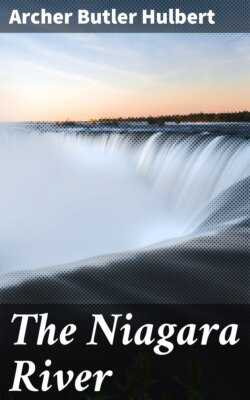Читать книгу The Niagara River - Archer Butler Hulbert - Страница 10
На сайте Литреса книга снята с продажи.
ОглавлениеSome years ago [writes Mr. Porter], Colin Hunter, then an Associate, now a Royal Academician, came over from London to paint Niagara. Of all the points of view he selected the one as seen up stream from the head of the Little Brother Island. A temporary bridge was built to it, and here, with a guard at the bridge, so as to be secure from intrusion, he painted his grand view, looking up stream. The upper ledge of rocks, with its long, rapid cascade, was his sky-line; in the foreground were the tumbling Rapids; far to the right of the picture the tops of a few trees appearing on the Canada shore above the waters alone showed the presence of any land. We advise . . . the visitor to clamber over the rocks on the Canadian shore of the Island . . . go out as near the water's edge as possible, and you will appreciate the difference that a few feet in a point of observation may make in what is apparently the same scenery. Just before you reach the foot of the island a gnarled cedar tree and a rock, accessible by leaping from stone to stone, gives you access to a point of observation than which there is nothing more beautiful at Niagara. Do not fail to get this view, for it is the Colin Hunter view, as nearly as you can get it, and you will appreciate the artistic sense of the great painter who chose this incomparable view in preference to the Falls themselves for a reproduction of the very best at Niagara.
Another beautiful point from which to view the Rapids is on Terrapin Rocks, the so-called scenic and geographical centre of Niagara. Here the power of the magnificent river, the "shoreless sea" above you, the clouds for its horizon, grows more impressive with every visit. By day the sight is marvellously impressive; by night, under some circumstances, it is yet more wonderful. Of this night view Margaret Fuller wrote, most feelingly:
After nightfall as there was a splendid moon, I went down to the bridge and leaned over the parapet, where the boiling rapids came down in their might. It was grand, and it was also gorgeous: the yellow rays of the moon made the broken waves appear like auburn tresses twining around the black rocks. But they did not inspire me as before. I felt a foreboding of a mightier emotion to rise up and swallow all others, and I passed on to the Terrapin Bridge. Everything was changed, the misty apparition had taken off its many coloured crown which it had worn by day, and a bow of silvery white spanned its summit. The moonlight gave a poetical indefiniteness to the distant parts of the waters, and while the rapids were glancing in her beams, the river below the Falls was as black as night, save where the reflection of the sky gave it the appearance of a shield of blue steel.
As the Falls of Niagara slowly creep backward in tune to their stupendous recessional toward Lake Erie they encroach more and more on the magnificent domain of the Rapids, nor will their gradual increase in height atone for this savage invasion nor palliate the offence committed. A thousand years more, we are told, and the visitor will view the "Horseshoe" Fall from the upper end of the Third Sister Island, and the marvellous canvas of Colin Hunter will be as meaningless as Hennepin's picture of two centuries and more ago. The American Fall, receding much more slowly than the Horseshoe Fall, will invade the beautiful rapids above Goat Island bridge at a very much later date, for, as we shall see, the greater fall recedes almost as many feet per year as the lesser recedes inches. And in this connection it is interesting to note that if the recession continued to Lake Erie and onward into that lake until the line of fall was a mile long at its crest, with the water falling 336 feet, Victoria Falls in the Zambesi River would still exceed their American rival by sixty-four feet in height!
